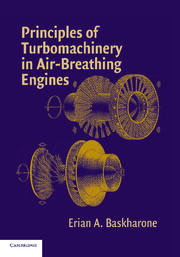Book contents
- Frontmatter
- Contents
- Preface
- 1 Introduction to Gas-Turbine Engines
- 2 Overview of Turbomachinery Nomenclature
- 3 Aerothermodynamics of Turbomachines and Design-Related Topics
- 4 Energy Transfer between a Fluid and a Rotor
- 5 Dimensional Analysis, Maps, and Specific Speed
- 6 Radial-Equilibrium Theory
- 7 Polytropic (Small-Stage) Efficiency
- 8 Axial-Flow Turbines
- 9 Axial-Flow Compressors
- 10 Radial-Inflow Turbines
- 11 Centrifugal Compressors
- 12 Turbine-Compressor Matching
- References
- Index
5 - Dimensional Analysis, Maps, and Specific Speed
Published online by Cambridge University Press: 05 September 2012
- Frontmatter
- Contents
- Preface
- 1 Introduction to Gas-Turbine Engines
- 2 Overview of Turbomachinery Nomenclature
- 3 Aerothermodynamics of Turbomachines and Design-Related Topics
- 4 Energy Transfer between a Fluid and a Rotor
- 5 Dimensional Analysis, Maps, and Specific Speed
- 6 Radial-Equilibrium Theory
- 7 Polytropic (Small-Stage) Efficiency
- 8 Axial-Flow Turbines
- 9 Axial-Flow Compressors
- 10 Radial-Inflow Turbines
- 11 Centrifugal Compressors
- 12 Turbine-Compressor Matching
- References
- Index
Summary
Introduction
In this chapter, a turbomachinery-related nondimensional groupings of geometrical dimensions and thermodynamic properties will be derived. These will aid us in many tasks, such as:
Investigating the full-size version of a turbomachine by testing (instead) a much smaller version of it (in terms of the total-to-total pressure ratio), an alternative that would require a much smaller torque and shaft speed, particularly in compressors;
Alleviating the need for blade cooling in the component test rig of a high-pressure turbine section by reducing (in light of specific rules) the inlet total temperature;
Predicting the consequences of the off-design operation by a turbomachine using the so-called turbine and compressor maps;
Making a decision, at an early design phase, in regard to the flow path type (axial or radial) of a turbomachine for optimum performance.
A good starting point is to outline the so-called similitude principle, beginning with the definition of geometric and dynamic similarities as they pertain to turbomachines.
Geometrical Similarity
Two turbomachines are said to be geometrically similar if the corresponding dimensions are proportional to one another. In this case, one turbomachine is referred to as a scaled-up (or scaled-down) version of the other. An obvious (but not silly) case here is the turbomachine and itself.
Dynamic Similarity
Two geometrically similar turbomachines are said to be dynamically similar if the velocity vectors at all pairs of corresponding locations are parallel to one another and with proportional magnitudes. In this case, the fluid-exerted forces, at corresponding locations, will be proportional to each other.
- Type
- Chapter
- Information
- Principles of Turbomachinery in Air-Breathing Engines , pp. 172 - 207Publisher: Cambridge University PressPrint publication year: 2006



